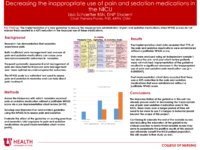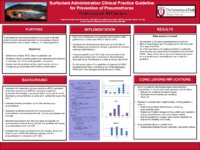The Graduate Nursing Project collection includes Doctor of Nursing Practice (DNP) Scholarly Projects and Master's students' non-thesis projects submitted as part of program requirements.
TO
- Graduate Nursing Project, Doctor of Nursing Practice, DNP, Neonatal24
- Graduate Nursing Project, Doctor of Nursing Practice, DNP, Neonatal, Poster17
- Graduate Nursing Project, Doctor of Nursing Practice, DNP16
- Graduate Nursing Project, Doctor of Nursing Practice, DNP, Nurse Midwifery Women's Health1
- Graduate Nursing Project, Master of Science, MS, Nursing Informatics1
- More
| Title | Creator | Date | Description | Relation Is Part Of | ||
|---|---|---|---|---|---|---|
| 1 |
 |
Infant Flowsheet Optimization | Phengphoo, Saifon | 2021 | Nursing documentation is crucial in several ways for delivering safe patient care and is used to support multiple components of care delivery. First, it is important for communicating patients' conditions and nursing care plans among healthcare providers, the patient's family, and other parties. Nur... | Graduate Nursing Project, Master of Science, MS, Nursing Informatics |
| 2 |
 |
Extended Dwell Catheters in the NICU | Chenoweth, Kimberlee | 2017 | Most infants in the newborn intensive care unit (NICU) require insertion of a device to acquire vascular access during hospitalization and this is the most common procedure in the NICU. New devices are met with uncertainty due to lack of evidence for their use. Extended dwell catheters (EDC) are new... | Graduate Nursing Project, Doctor of Nursing Practice, DNP |
| 3 |
 |
Evaluation of the Use of Neonatal Nurse Practitioners in Level I and II Neonatal Intensive Care Units | Dansie, Chad | 2015 | Neonatal Nurse Practitioners (NNPs) play a significant role in providing medical care for neonates in neonatal intensive care units (NICUs) across the United States. NNPs are employed in all levels of neonatal care due to their competence, skills, experience, and lower cost to hospitals and patients... | Graduate Nursing Project, Doctor of Nursing Practice, DNP |
| 4 |
 |
Quality Improvement Project: The Development of a Feeding Guideline for Neonates with Gastroschisis | Newton, Adriana | 2023 | Background: Gastroschisis is the most common abdominal wall defect treated in the neonatal intensive care unit (NICU). Well-defined standardized gastroschisis guidelines, multidisciplinary team collaboration during guideline development, and sufficient guideline directives regarding feeding progress... | Graduate Nursing Project, Doctor of Nursing Practice, DNP, Neonatal |
| 5 |
 |
Study of Pain Management Practices in Infants with Gastroschisis in a Level IV Newborn Intensive Care Unit | Fish, Jennifer | 2015 | Gastroschisis is an abdominal wall defect specific to the neonatal population, where the abdominal organs protrude through an opening next to the umbilicus. The severity of the defect varies between patients, but all infants with the diagnosis of gastroschisis will require surgical intervention. Pai... | Graduate Nursing Project, Doctor of Nursing Practice, DNP |
| 6 |
 |
Improving the Parent Experience in the Newborn Intensive Care Unit (NICU) Through Improved Provider Communication | Alston, Hailey; Hamilton, Jennifer; Chan, Belinda | 2021 | POSTER | Graduate Nursing Project, Doctor of Nursing Practice, DNP, Neonatal, Poster |
| 7 |
 |
Decreasing the Inappropriate Use of Pain and Sedation Medications in a Level III NICU | Schaeffer, Lisa; Phares, Pamela | 2020 | POSTER | Graduate Nursing Project, Doctor of Nursing Practice, DNP, Neonatal, Poster |
| 8 |
 |
Implementation of a Minimal Stimulation Guideline for Infants Less than 29 Weeks Gestation for the First Week of Life | Orr, Jennifer | 2020 | Background:The prevalence of prematurity is significant, with 1 in 8 live births occurring before 37 weeks gestation. More infants are surviving who are born between 22-28 weeks gestation. These infants are at high risk for adverse neurodevelopmental outcomes. Steps taken during the first week of li... | Graduate Nursing Project, Doctor of Nursing Practice, DNP, Neonatal |
| 9 |
 |
Implementation of Feeding Guidelines for Neonates | Elwood, Christine; Kranz, Clare | 2020 | POSTER | Graduate Nursing Project, Doctor of Nursing Practice, DNP, Neonatal, Poster |
| 10 |
 |
Optimizing time to treatment for Hypoxic Ischemic Encephalopathy (HIE) for Transported Neonates | DeLaney, Kathryn; Hamilton, Jennifer; Baserga, Mariana; DuPont, Tara | 2021 | Background: Most infants requiring therapeutic hypothermia (TH) therapy for Hypoxic Ischemic Encephalopathy (HIE) are born at facilities without therapeutic capabilities. There is a narrow timeframe for initiating TH, necessitating prompt identification, transport, and initiation of therapy. Quali... | Graduate Nursing Project, Doctor of Nursing Practice, DNP, Neonatal |
| 11 |
 |
Optimizing time to treatment for Hypoxic Ischemic Encephalopathy (HIE) for Transported Neonates | DeLaney, Kathryn; Hamilton, Jennifer; Baserga, Mariana; DuPont, Tara | 2021 | Background: Most infants requiring therapeutic hypothermia (TH) therapy for Hypoxic Ischemic Encephalopathy (HIE) are born at facilities without therapeutic capabilities. There is a narrow timeframe for initiating TH, necessitating prompt identification, transport, and initiation of therapy. Quali... | Graduate Nursing Project, Doctor of Nursing Practice, DNP, Neonatal |
| 12 |
 |
Surfactant Administration Practice Guidelines for Late Pre-Term and Greater Gestation Neonates | Brinkerhoff, Tia | 2017 | The purpose of this project was to develop a surfactant administration guideline to decrease the rate of pneumothoraces in moderate-late preterm and term neonates. Currently there are no clear guidelines for surfactant administration in this population yet research has pointed to significant benefit... | Graduate Nursing Project, Doctor of Nursing Practice, DNP |
| 13 |
 |
Decreasing the Inappropriate Use of Pain and Sedation Medications in a Level III NICU | Schaeffer, Lisa | 2020 | Background: Overuse of pain and sedation medications continue to be a problem in newborn intensive care units (NICU). The use of pain and sedation medications can have harmful long term neurodevelopmental sequlae and these medications should only be used when nonpharmacological interventions are not... | Graduate Nursing Project, Doctor of Nursing Practice, DNP, Neonatal |
| 14 |
 |
Prevention of Hypothermia at Delivery in Infants Born Preterm, at 28 to 34 Weeks Gestation, Through Implementation of a Clinical-Workflow Process | Rowley, Denise O. | 2022 | Background: According to the March of Dimes, 10% of infants born nationally in 2021 were born prematurely, at less than 37 weeks. In Utah, 1% of infants are born prematurely each year, between 28 and 34 weeks. Worldwide, hypothermia at delivery occurs at a rate of 30% to 90% among infants delivered ... | Graduate Nursing Project, Doctor of Nursing Practice, DNP, Neonatal |
| 15 |
 |
Evaluating the Effectiveness of an Existing Late Onset Sepsis Tool in a Culture-positive Patient Subgroup at a Level III Newborn Intensive Care Unit | Valadez, Marta G.; Hardin, Pamela | 2022 | Background: Late-onset sepsis is an overwhelming systemic response to a bacterial, viral, or fungal infection and a leading cause of neonatal morbidity and mortality. The Surviving Sepsis Campaign has recommended each unit have a systematic sepsis screening process. Implementing a screening approach... | Graduate Nursing Project, Doctor of Nursing Practice, DNP, Neonatal |
| 16 |
 |
Evaluation of the Parent Experience with Home Enteral Feeding Tubes in Infants Discharged from the Newborn Intensive Care Unit | Mitchell, Megan I. | 2022 | Background: Infants who spend time in the Newborn Intensive Care Unit must attain full oral feedings prior to discharge. Waiting for a clinically stable infant to attain full oral feedings can considerably increase their time spent in the hospital. Allowing these infants to discharge home with a fee... | Graduate Nursing Project, Doctor of Nursing Practice, DNP, Neonatal |
| 17 |
 |
Increasing Utilization of Extended-Dwell Peripheral Intravenous Catheters in the Neonatal Intensive Care Unit: A Quality Improvement Project | Shepherd, Laura | 2023 | Background: Repeated pain exposure in neonates is often associated with decreases in long-term cognitive and motor outcomes. Peripheral intravenous (PIV) catheterization attempts are a common source of pain. PIVs need to be replaced frequently given the nature of neonatal peripheral blood vessels. E... | Graduate Nursing Project, Doctor of Nursing Practice, DNP, Neonatal |
| 18 |
 |
The Infant Flowsheet Optimization Project | Phengphoo, Saifon | 2021 | POSTER | Graduate Nursing Project, Master of Science, MS, Nursing Informatics, Poster |
| 19 |
 |
Surfactant Administration Clinical Practice Guideline for Prevention of Pneumothorax | Brinkerhoff, Tia | 2017 | POSTER | Graduate Nursing Project, Doctor of Nursing Practice, DNP |
| 20 |
 |
Congenital Cytomegalovirus and Timely Newborn Hearing Screens in the NICU | Boogaard, Melanie | 2017 | Congenital cytomegalovirus (cCMV) is a prevalent infection that can have devastating adverse effects, such as hearing loss, vision loss, and neurologic deficit. Identifying an infant with cCMV can be difficult, as only 10% of infants are symptomatic and not every infant is screened. The purpose of t... | Graduate Nursing Project, Doctor of Nursing Practice, DNP |
| 21 |
 |
The Parent Experience With Home Enteral Tube Feedings After NICU Discharge | Mitchell, Megan I. | 2022 | POSTER | Graduate Nursing Project, Doctor of Nursing Practice, DNP, Neonatal, Poster |
| 22 |
 |
Implementation of Feeding Guidelines for Neonates | Elwood, Christine | 2020 | Background:Preterm neonates in the Neonatal Intensive Care Unit (NICU) require specialized care when it comes to their nutrition. Poor nutrition will further worsen an already complicated clinical course as well as increase morbidity, mortality, and poor neurodevelopmental outcomes. A thorough revie... | Graduate Nursing Project, Doctor of Nursing Practice, DNP, Neonatal |
| 23 |
 |
Placental Lab Draws in the Newborn ICU: A Quality Improvement Project | Evans, Ida Katrina; Hamilton, Jennifer | 2022 | Background: Obtaining an infant's labs from the placenta on admission is a relatively new practice in the Newborn Intensive Care Unit (NICU). This practice decreases phlebotomy losses, reduces blood transfusions, reduces iatrogenic blood loss, and decreases exposure to pain. There is a lack of stand... | Graduate Nursing Project, Doctor of Nursing Practice, DNP, Neonatal |
| 24 |
 |
Screening for Postpartum Depression in the Newborn Intensive Care Unit (NICU) | Roberts, Emilia G. | 2023 | Background: Postpartum depression (PPD) is one of the most common obstetric complications that women will experience, with a prevalence of 12.5% in the United States. Women with infants admitted to the Newborn Intensive Care Unit (NICU) are at an even more significant risk for developing PPD, with a... | Graduate Nursing Project, Doctor of Nursing Practice, DNP, Nurse Midwifery Women's Health |
| 25 |
 |
Bedside Oxygen Histogram Monitoring in the NICU for Infants at Risk for Retinopathy of Prematurity | Arslanian, Lindsay A.; Hamilton, Jennifer L. | 2022 | Background: Retinopathy of prematurity (ROP) is a vaso-proliferative disease process that is exclusive to premature infants and can be exacerbated by supplemental oxygenation administration. Infants that experience hypoxia and hyperoxia are at an increased risk of developing severe ROP. Bedside oxyg... | Graduate Nursing Project, Doctor of Nursing Practice, DNP, Neonatal |
